Legendary Spearfishing Charters in Crete & Greek Islands
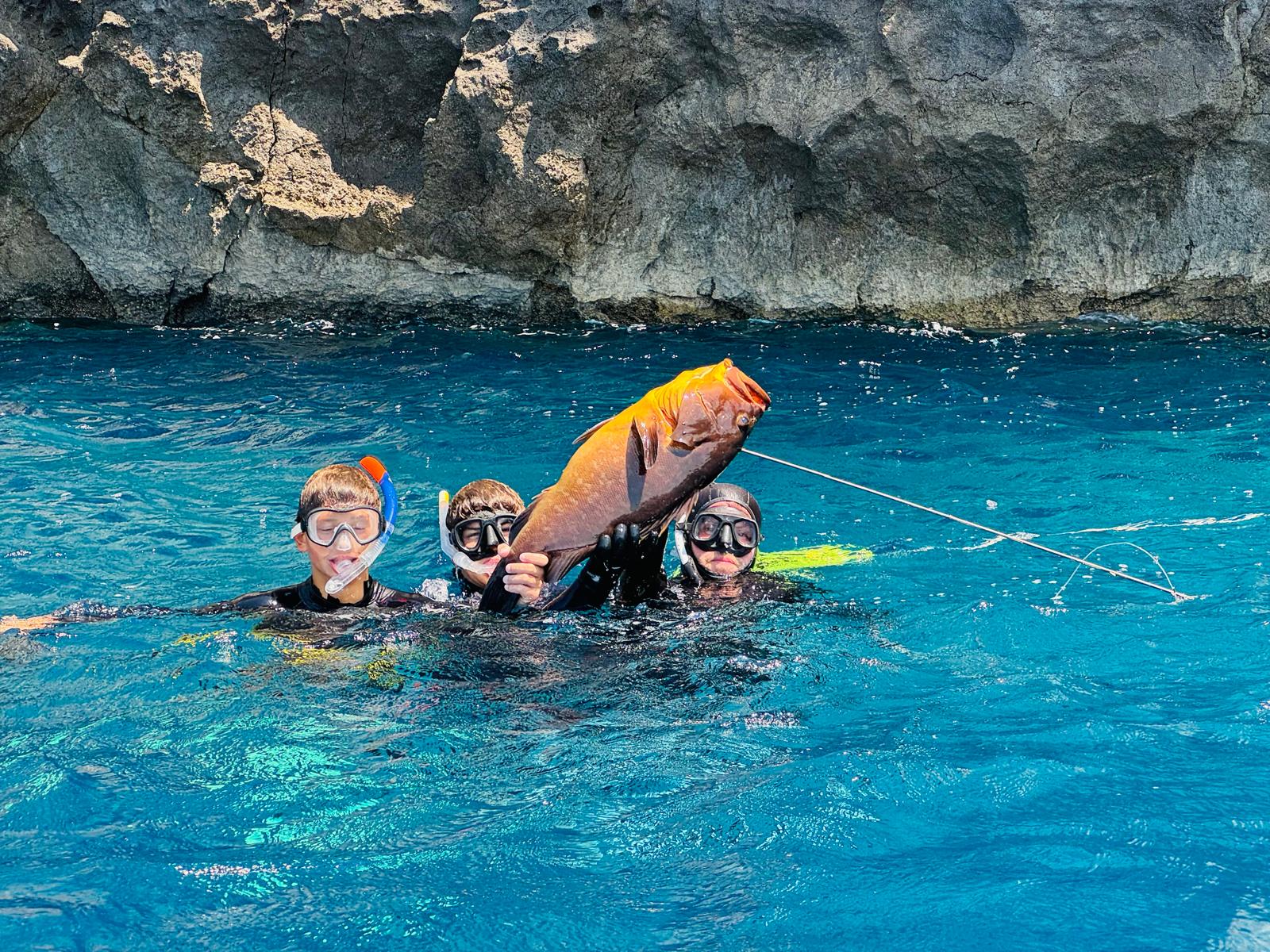
Published on: January 5, 2025
By PANOS BARDIS, Owner & Ceo of SEAZE THE DAY
experienced freediving instructor and a passionate local spearfishing enthusiast
Let’s Talk About Spearfishing in Greece!
Is it winter, and you’re already dreaming about your summer vacation in Greece? Maybe the stunning Greek islands and Crete are calling your name as you plan an unforgettable escape. Imagine adding something truly special to your trip. Learn to spearfish, sharpen your skills, or catch your own fish and savor it in the most sustainable way.
This is more than just an activity; it’s a passion we live and breathe every day. Our spearfishing charters in Crete and the Greek Islands are crafted with care, expertise, and a deep love for the sea. And whether you’re a beginner or a seasoned spearfisher, we’re here to guide you every step of the way.
In this guide, we’ll walk you through everything you need to know: the best fishing spots, the fish you can catch, how to spearfish responsibly, and even a few ideas for unforgettable spearfishing charters. So, let’s dive in and start planning your adventure of a lifetime!
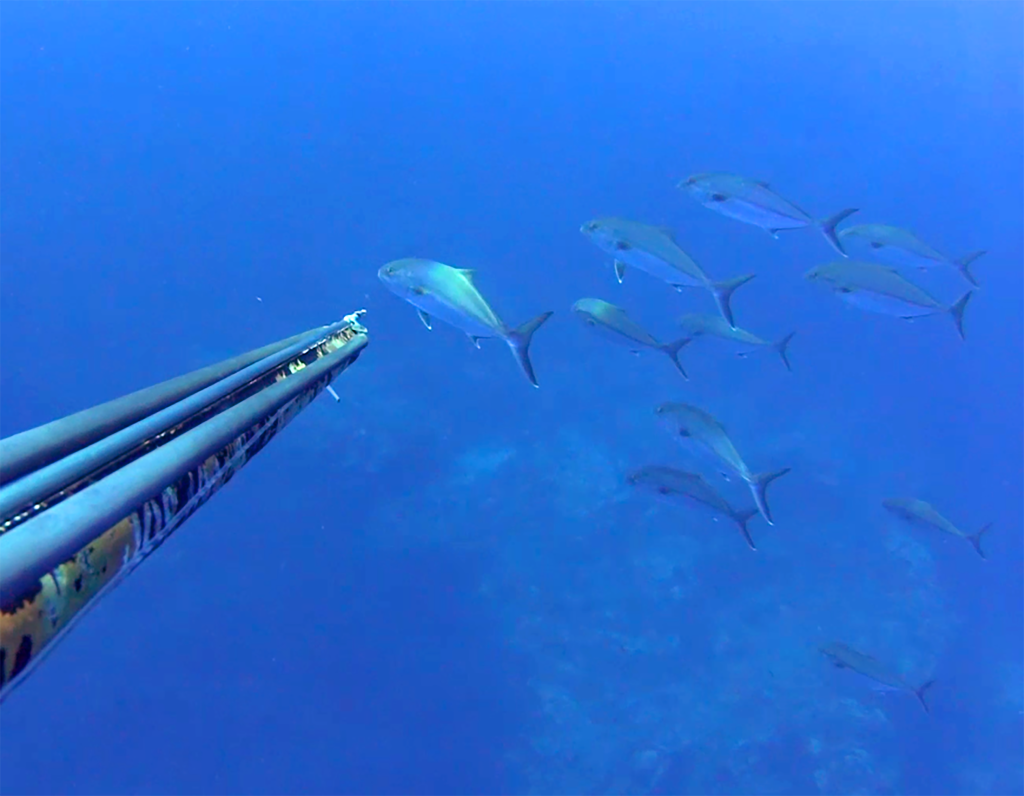
What is Spearfishing?
Spearfishing is the art of catching fish with a spear while diving. In Greece, and in most countries around the world, the only permitted way to spearfish is by holding your breath. This method, known as free diving, combines skill, patience, and a deep connection to the underwater world.
At its most basic, the equipment needed includes a mask and a speargun. However, to be fully equipped and comfortable, you’ll also need a snorkel, fins, a wetsuit, a weight belt, and a buoy. These tools not only enhance your experience but also ensure your safety and efficiency underwater.
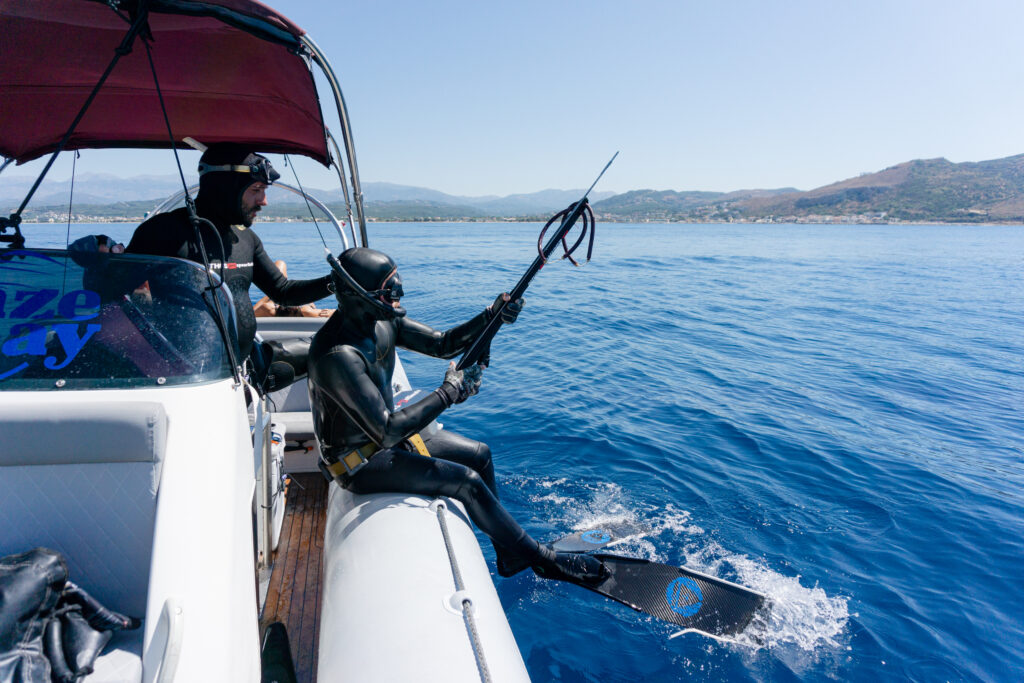
Essential Equipment for Spearfishing in Greece
In the following section, we will talk about what you need to bring if you are planning to come to Greece for spearfishing. If you’re trying spearfishing for the first time or don’t want to bring your own gear, don’t worry—we provide all the necessary equipment as part of our guided tours.
Mask
The most important part of spearfishing equipment is definitely the mask.

First, forget about snorkeling masks that cover the full face, nose, and mouth, which have become popular lately. These masks are unsuitable for spearfishing because you cannot equalize pressure, they have too much air volume, and they distort distances and sizes underwater.
A proper spearfishing or free-diving mask is low to medium volume, typically made from latex or, even better, silicone and glass. It only covers the eyes and nose, leaving the mouth exposed. Choosing the correct mask is vital! Many people, including experienced divers, find it challenging to switch to a different model once they get used to one.
How do you choose the correct mask? First, visit a dive shop and try on several masks. Place each mask on your face and try to inhale through your nose. If the mask stays attached to your face without holding it, and if you can’t breathe, it means no air is entering the mask, then it’s a good fit. For beginners, a mask with average volume is ideal. As you progress and dive deeper, a low-volume mask will make equalization easier and more efficient.
Snorkel
Another essential part of spearfishing equipment is the snorkel.

The snorkel is an elastic tube about 35-45 cm long, usually elliptical in shape, with a mouthpiece attached. It allows you to breathe on the surface while keeping your head submerged. This way, you can continuously observe the seabed and relax while preparing for your next dive.
Safety Tips
It’s crucial to remember that during a free dive, you must remove the snorkel from your mouth to ensure your mouth stays closed while holding your breath. This helps prevent water from entering your airway and allows for better control during the dive.
Additionally, never attach the snorkel to your mask with a clip. Instead, tuck it under the strap of your mask. This setup allows you to quickly remove the snorkel if needed, preventing accidental loss of your mask when moving near rocks or if it gets caught in ropes or nets. Properly managing your snorkel setup ensures a safer and more enjoyable spearfishing experience.
Fins
Fins are used for propulsion both underwater and at the surface.
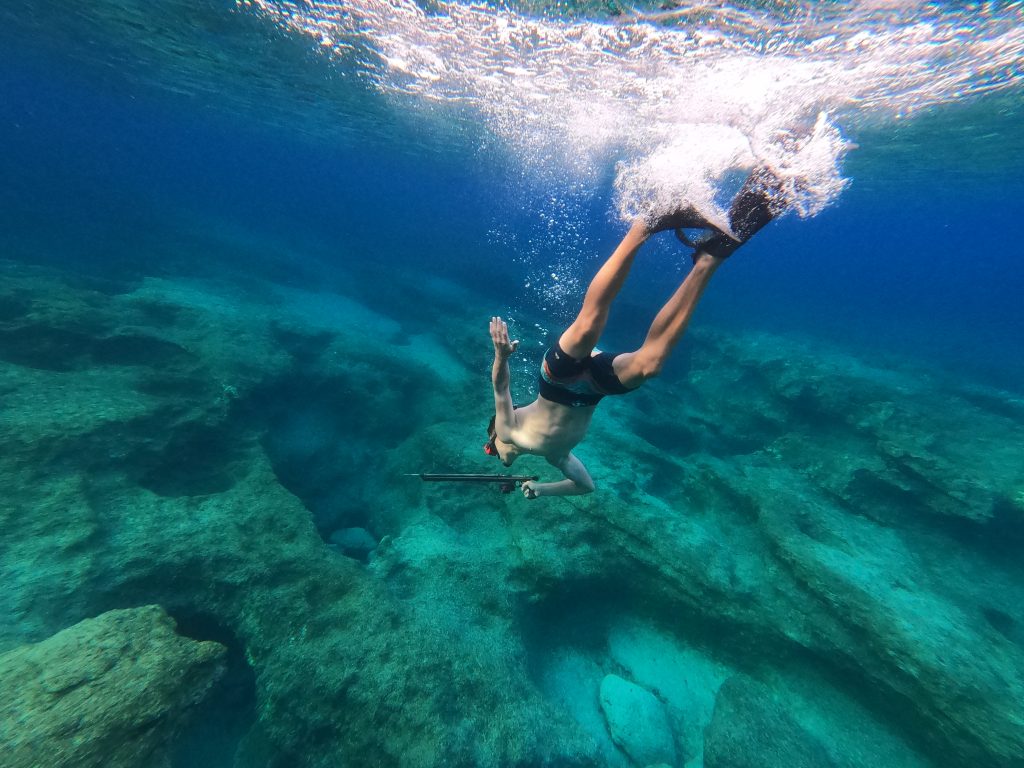
They come in various sizes, shapes, stiffness levels, and materials. For divers aiming to go beyond 6-7 meters, long fins are essential for better performance. However, beginners often find casual, average-sized plastic fins more comfortable and easier to use.
Today’s spearfishing fins are often made from carbon fiber, paired with different types of foot pockets made from materials like latex, hard silicone, or other composites. As a mechanical engineer, my diploma thesis was on the Performance Evaluation of Swim Fins Under Zero Translation Speed, and I can confidently say this: the correct foot pocket must match the blade and the diver’s technique. The blade should not be too stiff, but at the same time, it needs to be flexible and responsive for efficient propulsion.
The cost of fins varies widely depending on the material and purpose. A pair of snorkeling fins may cost around 60 to 80 euros, which is sufficient for those aiming to fish for fun in shallow waters. Plastic long fins typically range from 100 to 150 euros, while high-performance carbon fiber fins can cost between 350 to 500 euros.
Fin Technique Tips:
- Master Your Technique: Proper technique greatly influences the efficiency of your dive. It helps reduce oxygen consumption, increases propulsion, and results in longer and safer dives.
- Avoid Bicycle Kicking: Do not kick the water like pedaling a bicycle. Instead, focus on “pushing water,” ensuring the fin works equally well in both forward and backward movements.
- Engage Your Hips: Generate power from your hips with smooth, harmonious movements. Keep your body relaxed and engage only the necessary muscles to maximize efficiency.
Speargun
Nowadays, spearguns have become highly advanced.

In the market, you’ll find a wide variety of options, including rubber-powered and pneumatic (air-powered) spearguns, models with two or three rubbers, and spearguns of various sizes. Additionally, spearguns can have different types of shafts, such as Tahitian, three-pronged, or five-pronged heads, each suited for specific techniques and targets. Finally, specialized spearguns like rollers and inverted rollers stand out for their advanced features, offering enhanced power and precision in the water.
Which is the ideal speargun for spearfishing in Crete and the Greek islands?
The answer isn’t straightforward—it largely depends on the skill level of the spearo and the technique they use.
If I were to choose a single speargun, I’d go for a versatile model measuring 75-85 cm. This size refers to the length of the tube, not including the handle and the head of the gun. A setup with one or two pairs of rubber bands, a Tahitian-type shaft, and a reel (moulinet) is an all-time classic. This reliable and adaptable choice works well for most spearfishing conditions in the Greek waters.
Wetsuit
The spearo’s free-diving wetsuit is a vital part of the gear that keeps you warm and lets you enjoy your underwater adventures.
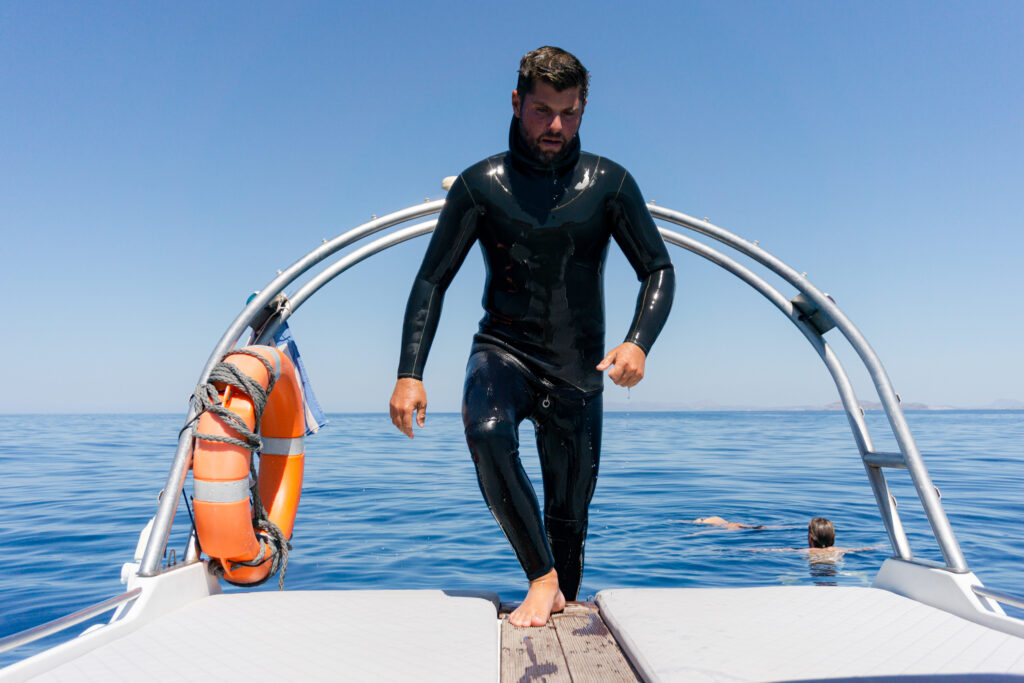
It has two main pieces. The pants, which cover the legs and extend slightly below the chest, and the upper part, which includes an integrated hood and covers the torso.
In general, for warmer months, a 3mm wetsuit is usually sufficient, while winter diving often requires a thicker suit of 8-9mm. Wetsuits are made from various types of neoprene, including Yamamoto, Heiwa, Seiko, and Daiwabo. Each of these, with its own advantages and drawbacks. Designs also vary, with some having a smoothskin or nylon exterior, while most feature an open-cell interior for better insulation.
Water Temperature Graph for Chania, Crete
Below is a graph illustrating the average water temperatures in Chania, Crete, throughout the year:

Average Water Temperatures in Greece
To explore detailed water temperature data across Greece, visit the official resource.
Recommended Wetsuit Thickness Based on Water Temperature

Secondary but Necessary Spearfishing Equipment
Weightbelt
The weightbelt is an essential part of spearfishing equipment, particularly for those wearing a wetsuit. Wearing a wetsuit alters the body’s buoyancy, making it more positive, similar to wearing a life jacket. Thicker wetsuits require additional weights.
For example, a general guideline suggests matching the wetsuit’s thickness in millimeters to the weight in kilograms. A 5mm wetsuit, for instance, often requires about 5kg of weights.
To fine-tune the balance, aim for slightly negative buoyancy at your fishing depth. Additionally, consider reducing weights for deeper dives to facilitate an easier ascent. In shallow waters, more weights may be necessary.
Keep in mind, this process can be affected by factors such as wetsuit material quality, individual body composition, and diving technique. Experimenting with detachable weights in the water helps determine the ideal configuration for your needs.
Gloves
Spearfishing gloves protect your hands from sharp rocks, fish spines, and underwater hazards while providing a better grip on your equipment.
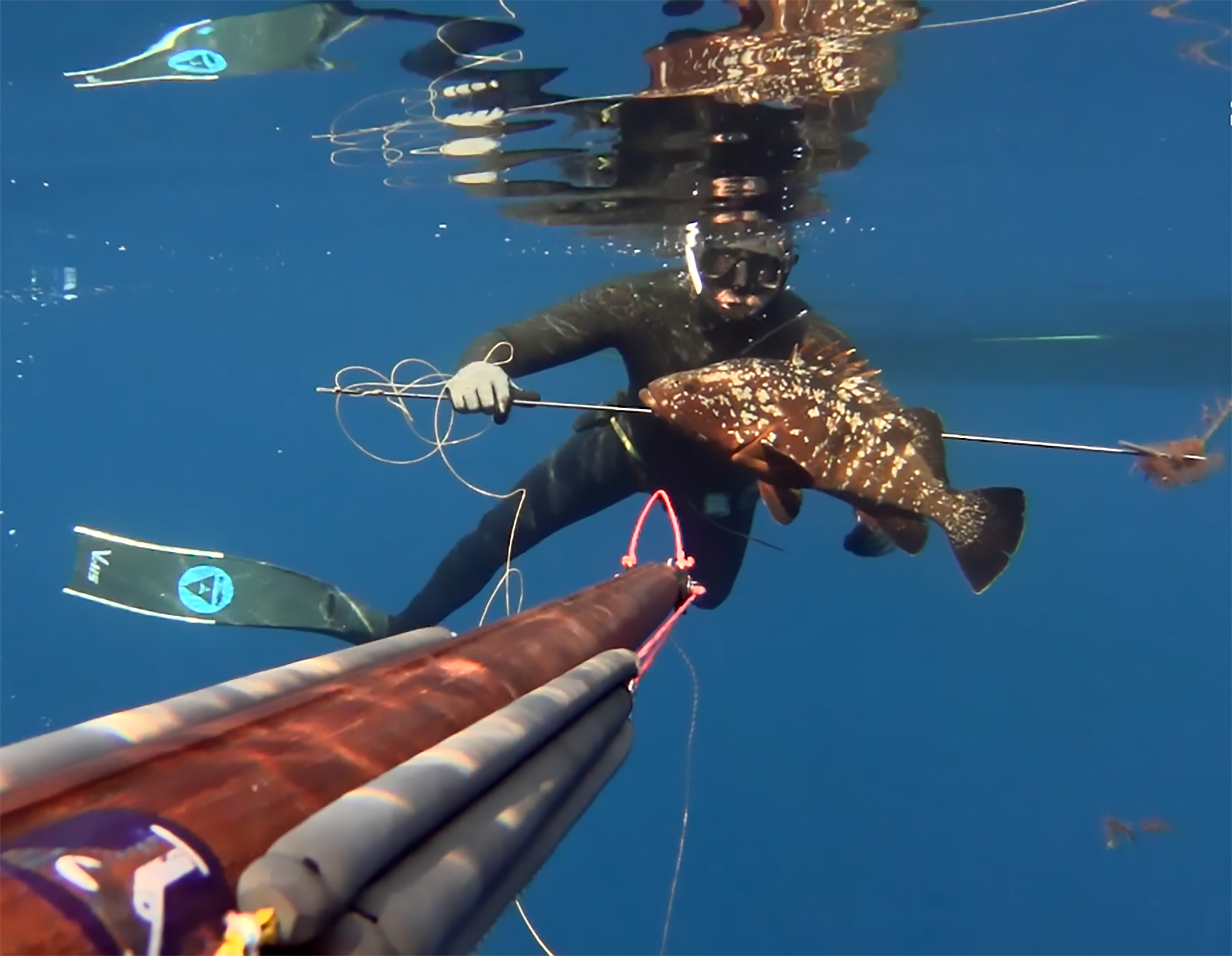
When choosing gloves, I personally recommend opting for ergonomic gloves that feel like you’re not wearing any at all. A good sense of touch is crucial for tasks like fixing the speargun, inserting the shaft, adjusting the fishing line that connects the speargun to the shaft, or placing fish on the fish stringer.
In case of emergencies or unexpected tangles with fishing nets or the speargun line, thinner, more flexible gloves make it easier to untangle yourself or grab your knife quickly. While thicker gloves provide better insulation and protection against the cold, prioritizing dexterity and functionality is more important—even in winter.
The best gloves often combine neoprene on the upper part for insulation and leather on the palm side. The leather retains excellent tactile sensitivity even when wet, making it ideal for handling equipment with precision.
Dive Socks
Dive socks are made from neoprene and come with different textures. They can have nylon both inside and outside, smoothskin on the outside with open cell on the inside, or a combination of these textures.They also come in various thicknesses, ranging from thin 1.5-2mm options to thicker ones up to 5mm.
Personally, I recommend thin and elastic dive socks (1.5-2mm), even during the winter season. In summer, a pair of socks can still be beneficial, as it helps reduce the total weight needed on your belt and adds extra comfort.
Choosing the right socks is essential for ensuring your spearfins fit snugly on your feet. Socks that are too loose can cause blisters, you may lose your fin while swimming, or your fins may not be as efficient. On the other hand, socks that are too tight can become uncomfortable during long hours in the water. Look for a balance that keeps your fins tight enough without causing discomfort.
Dive Buoy
A dive buoy is one of the most essential pieces of equipment for any underwater activity, especially spearfishing. It is a cylindrical floating device, typically bright yellow, that features a flag to indicate underwater activity. The buoy can be made of inflatable PVC or neoprene or constructed from more rigid materials.

Why is a dive buoy important?
- Safety: In Greece, especially during the busy summer months, a dive buoy is crucial for ensuring your visibility to passing boats. By law, boats must maintain a safe distance of at least 100 meters from the buoy.
- Convenience: Apart from safety, the buoy allows you to carry additional equipment such as spearguns, fish stringers, water bottles, or other accessories using the appropriate straps.
The buoy is equipped with floating rope and a reel to manage excess rope length. If you’re using variable weights during your dive, a thicker sinking rope can be helpful for retrieving your weights from the seabed while reducing tangling risks.
Never dive in Greece, particularly during the high season, without a properly marked dive buoy—it is your best defense against potential hazards while enhancing the overall convenience of your spearfishing experience.
Spearfishing Methods for Greek Waters
It’s time to dive into the tried-and-true methods of spearfishing that work best in the waters of Greece. This section will cover fundamental techniques, share insider tips, and provide insights into adapting your approach to the unique underwater environments of Crete and the Greek Islands.
As the renowned Greek poet Odysseas Elytis once wrote:
“It is while fishing that the sea arrives, and it is within her depths that the fish gleams.”
Spearfishing in Greece is not just a skill—it’s a connection to nature and tradition. Let’s explore the key methods to help you navigate these waters with confidence.

Here, we’ll delve into four primary methods of spearfishing, each with its own variations, and we’ll end with a special “hidden” technique that’s less commonly discussed.
Drifting
Drifting, or “pianata,” is considered the foundation of all spearfishing techniques. It serves both as a method for locating fish and a technique for capturing them, making it an invaluable skill for any spearo.
Drifting as a Fish Locating and Capturing Method
Drifting is particularly useful in medium to deep waters where the seabed may not be easily visible due to depth or reduced clarity. It’s also ideal for unfamiliar areas or extensive rocky terrains with uniform depths, where fish can be scattered.
Drifting can be executed in two primary ways:
Mid-Water Drifting
This technique focuses purely on locating fish. You remain at mid-water levels while swimming horizontally, scanning below for movement or signs of fish. It is a less demanding approach since you stay close to the surface, avoiding deep dives. This allows you to conserve energy, enabling you to cover larger distances efficiently while searching for fish.

Three-Quarters Depth Drifting
This hybrid technique combines fish locating with the potential for capture. You position yourself at three-quarters of the depth, swimming horizontally but close enough to the seabed so you can approach fish within the same dive. For example, in a depth of 25 meters, you dive vertically to around 10-12 meters and then stop all fin movements. From there, you begin a diagonal descent, observing the seabed as you approach. When you reach a depth of 16-18 meters, you continue to swim horizontally, scanning for fish.
Once your dive is complete, you ascend vertically back to the surface to rest and recover before repeating the process. This technique demands longer breath-holds and precise dive preparation, allowing you to cover ground effectively and increase your chances of a successful catch.
For this method, the ideal equipment includes medium- to long-range spearguns. A 90 cm speargun or longer is excellent for open-water shots, while an invert roller speargun of 82 cm or more offers enhanced versatility, making it perfect for a mix of locating and capturing fish.
Drifting as a Method for Capturing Fish
Stealth is Key
When preparing for a drift to approach your target, maintaining stealth and silence is critical. This includes smooth, controlled dives, avoiding rushed equalizations, and moving at a slow, deliberate pace that differs from typical fish movement. These actions help avoid alarming the fish.
Utilize Negative Buoyancy
Take advantage of negative buoyancy as you descend. Once you achieve this state, stop using your fins completely and glide silently toward the fish. This approach reduces unnecessary movements and noise, increasing your chances of a successful capture.
Minimize Your Profile
To avoid detection, reduce your visibility by minimizing your profile. Align your body so that the fish sees only a small portion of you. Depending on the situation, you can use a vertical or diagonal (sideways) approach. Ensuring that your body remains aligned with an imaginary straight line from the surface to the fish allows for a stealthy and efficient descent.
Leverage Sunlight
If possible, position yourself with the sun behind you. This tactic hinders the fish’s ability to see you clearly, as the glare from the sunlight obstructs its vision. Similar to how sunlight can affect our ability to see, this trick creates a significant advantage when approaching your target.
Choose the Right Equipment
Properly balanced weights are crucial for effective drifting, ensuring smooth descents and stability. Additionally, select a speargun that’s ideal for long-range shots in open waters. A 90 cm speargun or larger or an invert roller of 82 cm or more provides the precision and range needed for capturing fish during this technique.
Hole or Rock Hunting
Stalking is one of the classic spearfishing techniques, offering a versatile approach that can be highly effective in a variety of underwater environments. While drifting is more suited for medium to deep waters, rock hunting can excel also in very shallow waters, making it a technique accessible to spearos of all skill levels.
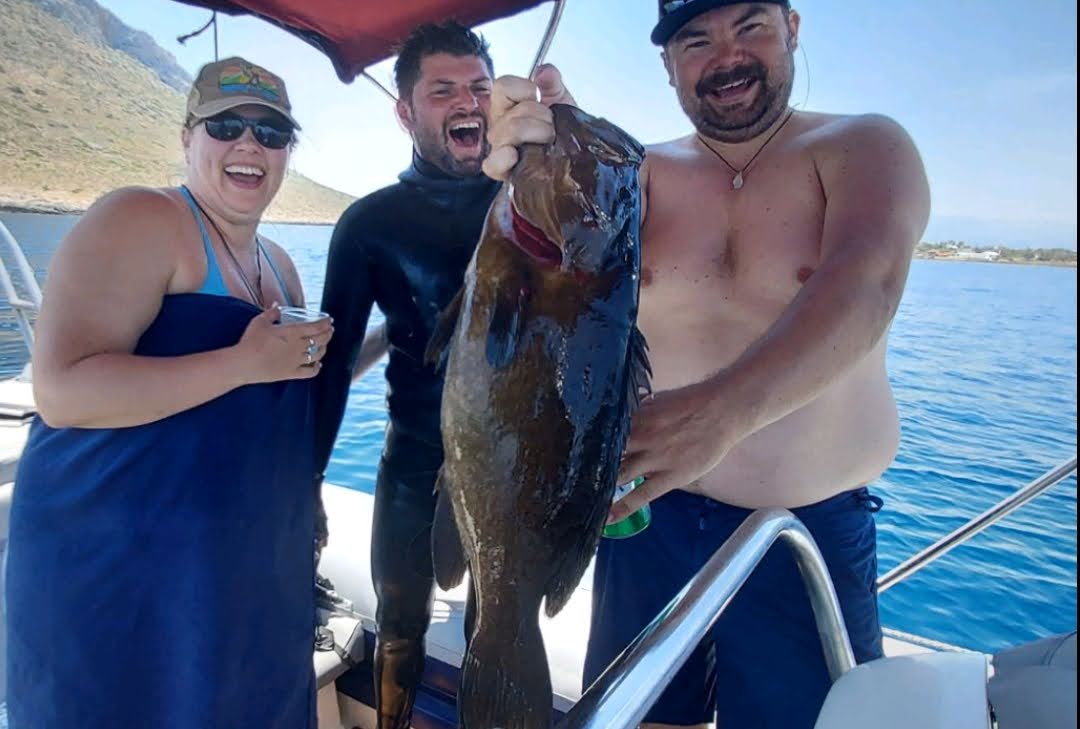
Where and What Can You Catch?
Rock hunting is ideal for shallow-water fishing, where a range of fish species can be targeted. Depending on the terrain and your approach, the fish you can catch include:
- Whitefish: Species like seabream (sarago), saddled seabream (melanouria), mullets (kephaloi), and occasionally gilt-head bream (tsipoura). These are often found in shallow, sandy, or rocky areas.
- Rockfish: Groupers (rofos), golden groupers (stira), dusky groupers (sfyrida), lionfish, scorpionfish (skorpidia), and other reef-dwelling species. These are typically located in rocky crevices, caves, or among dense vegetation.
How to Execute Rock Hunting
Most edible and flavorful fish in Greek waters rely on rocky formations for their habitat. These areas serve as homes, ambush points, or colonies where fish gather. At the top of this underwater hierarchy are the Epinephelus species, such as dusky groupers (rofos), golden groupers (stira), white groupers (sfyrida), and mottled groupers, with large groupers being the ultimate prize.
During rock hunting, the goal is to search within dark crevices or caves formed by clusters of rocks. This can be done in two main ways:
- Blind Search: Exploring rocky formations without having spotted any specific target beforehand, scanning for potential fish.
- Tracking a Known Target: Observing a fish entering a crevice or cave and carefully preparing for an approach.
The Process: Step by Step
Suppose you spot a fish entering a rocky hideout from the surface. While explaining every detail of the technique can be challenging in writing, here’s the basic idea:
- Silent Approach: Move toward the crevice as quietly as possible, ensuring that your movements don’t alert the fish.
- Remain Hidden: Approach the crevice or cave from a point that keeps you out of the fish’s direct line of sight.
- Minimize Your Profile: Reduce your visible profile by aligning your body and keeping your movements smooth and controlled.
- Ready Your Speargun: Enter the crevice with your speargun aligned with your line of sight, ready to fire at the first opportunity. Ensure your hand holding the speargun is steady and prepared to take a quick, precise shot.
Recommended Spearguns for Rock Hunting
For stalking in rocky environments, smaller spearguns are ideal:
- 55-75 cm tube length for general crevice fishing.
- Up to 90 cm for larger groupers in bigger crevices.
- An 82 cm speargun is a versatile choice for most situations.
Optimal Setup:
- Shaft: A single-flopper 6.25 mm to 6.5 mm stainless steel shaft with the flopper on top.
- Rubber Bands: Either a 19 mm single band or two 14 mm soft bands paired with a 6.25 mm shaft.
By following these techniques, you can effectively navigate the rocky underwater terrain and maximize your chances of success while rock hunting.
Ambush Hunting
Ambush, known as “Aspetto”, is one of the most significant and technical methods of spearfishing, especially effective in Greek waters. This technique focuses on attracting the prey using two distinct approaches.
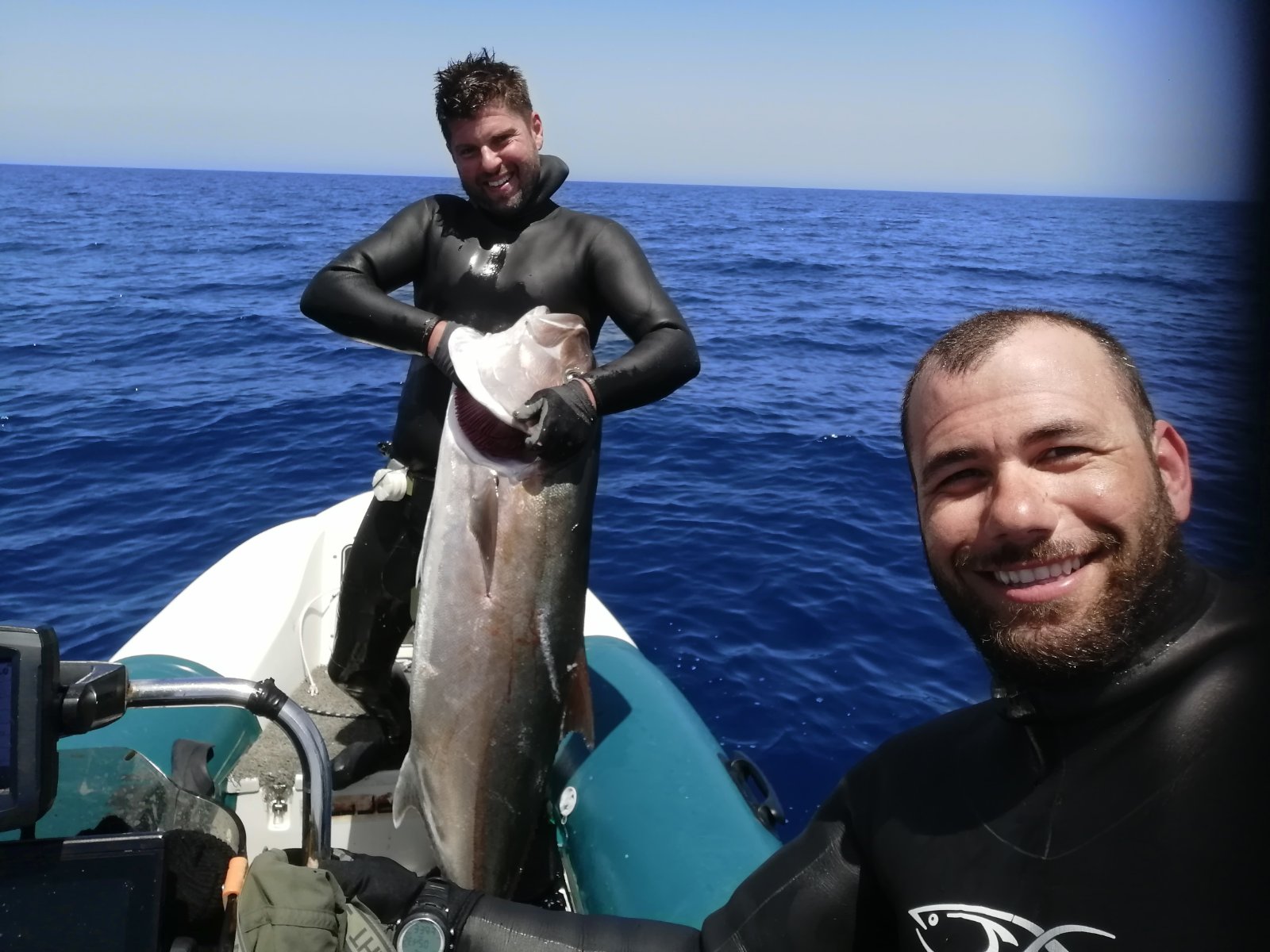
- Strategic Concealment:
The goal is to position yourself in a strategic location, completely hidden from view, targeting fish that are unaware of your presence. This is similar to how groupers patiently wait in the shadows to ambush their prey.- The ambush spot should be carefully selected, ideally in a pathway frequented by fish or in an area where fish naturally hunt smaller prey.
- Remaining completely still and hidden is crucial to avoid alerting the fish.
- Triggering Curiosity:
The second aspect of this technique leverages the natural curiosity of fish.- As you descend slowly during your dive, fish in the vicinity may sense your presence or observe you. When you move out of their line of sight and remain still, hidden on the seabed, they may become intrigued by what has “fallen from the sky.”
- Smaller fish may approach out of curiosity or mistake you for potential food, while larger predatory fish, such as amberjacks and dentex, may emerge to assert their dominance. These territorial species often make their presence known to an “intruder” in their environment.
This method combines stealth, strategic positioning, and an understanding of fish behavior, making it a highly rewarding technique for experienced spearfishers.
Preparation and Execution of an Ambush Dive
1. Choosing Your Ambush Spot
The first step is to identify your ambush spot, either from the surface or based on previous dives. During your preparation, visualize the entire dive, from start to finish. The key is to have a clear mental plan for the dive, ensuring a smooth execution.
2. Surface Relaxation
While floating horizontally on the surface, remain completely still, allowing your body and mind to relax. This includes slowing your heart rate and waiting a sufficient amount of time since your last dive to allow for full recovery.
- Recovery Time: This varies depending on the depth and effort of the previous dive. As a general rule, allow at least 5 minutes and, in some cases, more than 10-12 minutes for deeper dives.
3. Breathing and Descent Preparation
After relaxing, take your final breaths: slow, deep inhalations and exhalations without hyperventilating. On your last breath, take a deep inhale, remove the snorkel from your mouth, and prepare for the descent.
4. Starting the Dive
- Bend your waist and lift your legs high to initiate the dive.
- Push down with one hand while starting strong kicks to overcome the positive buoyancy of the initial meters.
- As you descend deeper, progressively reduce the intensity of your kicks until you reach neutral buoyancy. Once past this point, take advantage of negative buoyancy and stop all active leg movements, gliding silently toward the seabed.
5. Maintaining Hydrodynamics
While descending, remain as hydrodynamic as possible:
- Keep your body vertical relative to the seabed.
- Avoid unnecessary movements to maintain your streamlined position.
- Keep your head facing forward, looking into the blue, not directly at the seabed. This reduces drag and helps maintain a stealthy descent.
6. Equalizing Pressure
Throughout the descent, equalize the pressure in your ears by pinching your nose and blowing gently. Begin equalizing from the first meters of the dive and continue regularly until you reach the desired depth. For a dive to 20 meters, you may need to equalize at least 6-7 times, even before feeling any discomfort.
7. Adjusting Your Trajectory
In the final meters of your descent, slightly adjust your trajectory to approach the seabed at an angle of 40-60 degrees. This allows you to scan the area for fish while moving toward your chosen ambush spot. Once you arrive, align your body horizontally to blend into your surroundings.
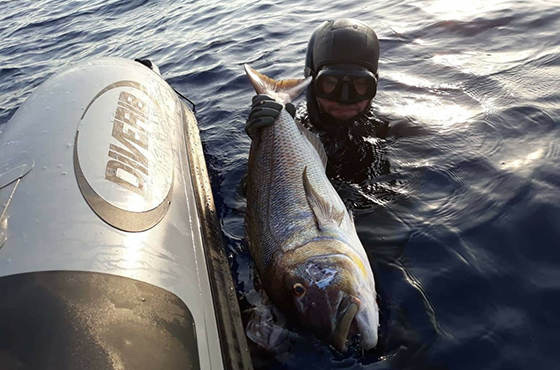
The Ambush Moment
Upon reaching your ambush spot:
- Remain motionless: Stay as still as possible to avoid alerting the fish.
- Be patient: Wait until a fish comes within range of your speargun.
- Take the shot: Once the fish is within your effective shooting range, press the trigger for a clean shot.
The Ascent
Regardless of whether the ambush was successful:
- Begin your ascent vertically.
- Start with strong kicks to overcome negative buoyancy and regain momentum.
- As you approach the final meters before the surface, stop all movements and allow the positive buoyancy to carry you upward effortlessly.
Post-Dive Recovery
Once you reach the surface:
- Take a few short, sharp breaths, if needed, to stabilize your oxygen levels (this is the only time hyperventilation is acceptable).
- Signal your OK to your dive partner to indicate you’re safe and ready for the next dive.
Ambush Spearfishing: Tips and Secrets
Mastering ambush spearfishing requires not only skill but also strategic thinking and a keen sense of observation. Here are some essential tips and techniques to refine your approach:
1. Choose the Right Spot
Selecting the ideal ambush location is key. Look for areas that provide both cover and strategic positioning. Some examples include:
- Natural Trenches: Small depressions or “foxholes” in the seabed, often surrounded by rocks, offering natural concealment.
- Drop-Offs: The edge of a reef or rocky area where the depth transitions, for instance, from 20 to 25 meters. These spots are prime hunting grounds for larger fish.
- Seagrass Beds: Areas with dense vegetation can provide excellent cover while attracting a variety of fish.
- Open Sand Areas: Sometimes, being exposed is effective. You can stir up sand to create a cloud, using it as camouflage or as a means to attract fish.
2. Mimic Natural Movements
Fish are naturally curious about certain behaviors in their environment. Use these techniques to draw them closer:
- Octopus Imitation: Simulate the movements of an octopus, subtly changing your posture and size to pique their interest.
- Feign Vulnerability: If fish approach, attempt to retreat or “hide” to create the impression of fear. This can trigger their predatory instincts.
- Noise and Bubbles: Producing gentle sounds or releasing a few air bubbles can attract fish by stimulating their curiosity.
3. Observe Fish Behavior
Pay attention to the activity of smaller fish. Their movements can reveal the presence of predators:
- Nervous Swarms: Sudden, erratic movements of small fish often indicate that a predator is nearby.
- Clustered Shoals: Schools of fish gathering near specific spots may signal a safe and resource-rich area to execute your ambush.
4. Experiment and Adapt
Every situation in the sea is unique. Experimentation and experience will guide your actions over time. Learn to adapt your approach based on:
- The species of fish present.
- The underwater terrain.
- Environmental conditions, such as light, currents, and visibility.
By combining these techniques with patience and observation, you’ll increase your chances of a successful catch while mastering the art of ambush spearfishing.
Agguato: The Art of Stealth Movement
Agguato is one of the most advanced spearfishing techniques, focusing on stealth and adaptability. Often seen as an evolution of the ambush method, this technique involves gliding between rocks and natural underwater structures to surprise fish. Inspired by the hunting strategies of marine predators like seals, aquato requires exceptional control and quick decision-making.
How It’s Performed
In agguato, the spearfisher moves close to the seabed at a slow, deliberate pace. Using rocks and underwater formations as cover, the diver minimizes their visibility to fish, positioning themselves for a surprise attack. This stealthy approach mimics the natural behaviors of predatory fish and marine mammals, leveraging the element of surprise.
The Key Steps
- Controlled Movements:
The diver moves with slow, fluid motions to avoid startling fish. The free hand is used to pull the diver forward by grasping rocks or the seabed, while the rest of the body remains buoyant and streamlined. Legs are primarily used for steering, acting as rudders rather than propulsion tools. - Maintaining Buoyancy:
Proper weight adjustment is crucial to stay neutrally buoyant. This allows the diver to float effortlessly above the seabed without creating noise or excessive movement, reducing oxygen consumption. - Adapting on the Go:
One of aquato’s greatest strengths is its flexibility. When fish are spotted, the technique can shift instantly:- From gliding to ambush mode, where the diver waits patiently for the fish to come closer.
- To an immediate shot when the fish is within range.
The Demands of Agguato
Agguato is a physically demanding technique due to the combination of movement and the need for extended breath-holds. It requires:
- Hydrodynamics: Maintaining a streamlined posture to move quietly and efficiently.
- Quick Reflexes: Reacting swiftly when fish appear unexpectedly.
- Focus and Stamina: Staying calm under pressure while managing oxygen levels during continuous motion.
Choosing the Right Equipment
- Spearguns:
While ambush spearfishing prioritizes maximum range with long, multi-band spearguns (e.g., 100 cm or longer), aquato benefits from a hybrid speargun that balances range and maneuverability. A speargun between 90-110 cm is ideal for this technique.- Longer Spearguns: Effective in areas with excellent visibility.
- Shorter Spearguns: More suited for murky waters or when swell conditions make larger guns harder to handle.
- Buoyancy and Weight Adjustment:
Proper weight calibration ensures smooth movement and prevents unnecessary strain. Neutral buoyancy is essential for gliding seamlessly between obstacles.
Environmental Factors to Consider
- Visibility: Clearer water allows for longer-range shots, requiring larger spearguns. Conversely, murkier water necessitates shorter, more agile guns.
- Current and Swell: Rough waters can make it harder to control movements and equipment. Adapt your approach and tools accordingly.
- Depth: Adjust your techniques and equipment based on the depth of your dive, as deeper areas often demand longer breath-holds and quieter movement.
The Power of Experience
Aquato is a versatile and highly effective technique, but it takes time and practice to master. Every dive presents unique challenges, from varying fish behaviors to the underwater terrain. By observing, experimenting, and honing your skills, you’ll develop the adaptability needed to excel in this demanding but rewarding method.
Spearfishing Regulations in Greece
In this section, we’ll cover the essential legal framework and restrictions regarding recreational spearfishing in Greece.

Restricted Areas
- Spearfishing is not allowed in harbors, port entrances, organized beaches, or areas designated as national marine parks.
- It is also forbidden near swimmers or within marked swimming zones.
- Spearfishing is prohibited in rivers and lakes.
- Ensure you maintain at least 200 meters distance from harbors, ports, and beaches.
Seasonal Ban
- Spearfishing is entirely banned during May. This regulation stems from an older law aimed at protecting fish during spawning season, though it may not align with all current scientific findings.
Free Diving Only
- Spearfishing is only permitted through free diving. Using breathing apparatus is strictly prohibited.
Night Spearfishing
- Spearfishing during nighttime hours (from sunset to sunrise) is not allowed. Additionally, the use of underwater flashlights is forbidden.
Catch Limits
- Each spearfisher can catch up to one fish from the Epinephelus (grouper) family per day.
- The total daily catch is limited to 5 kilograms per person. However, if a single fish weighs more than 5 kilograms, it is permissible to keep only that fish.
- When using a boat, the total catch must not exceed 10 kilograms per boat or one large fish exceeding 5 kilograms per person.
Fish Size Limits

Key Notes
1.Regulations for minimum sizes are based on:
- EU Regulation 1967/2006
- Presidential Decree 144/1986
- B.D. 26-01-1954
2.”Not Specified” Entries:
- Where “Not Specified” is indicated, no official legal minimum size is defined in the legislation.
- Suggested sizes are included to encourage sustainability and respect for fish maturity.
3.Always respect the minimum size requirements for various species, as outlined in Greek fishing regulations.
For More Information
Visit the official Greek Fisheries Control Directorate website for a full list of fish species in Greek waters, including photos, names, and size limits. You can also check their official PDF guide on fish size limits for detailed regulations.
Mandatory Equipment
- Dive Buoy: Using a dive buoy is essential. The buoy must be yellow and display a flag with the initials indicating underwater activity.
- Proximity to Buoy: Ensure you remain within 50 meters of your buoy at all times.
No Selling Your Catch
- Selling fish caught through spearfishing is strictly prohibited.
Fishing License Requirements
- Visitors from abroad should note that, as of January 18, 2025, no additional recreational fishing license is required for any form of recreational fishing, including spearfishing.
Key Guidelines to Remember
- Never Dive Alone: Always dive with a partner to ensure safety. This is the most crucial rule for spearfishing.
- Select Safe Locations: Respect restricted areas and avoid high-traffic zones.
- Use a Dive Buoy: Ensure your buoy is clearly visible and complies with legal requirements.
By following these regulations and prioritizing safety, you can enjoy a fulfilling and sustainable spearfishing experience in Greece.
Exotic and Dangerous Species in Greek Waters
Greek waters are among the safest in the world for underwater activities. Warm waters, excellent visibility, the absence of large predators near the coasts, and minimal strong currents make Greece an ideal destination for spearfishing and other aquatic pursuits.
Safety from Predators
While large marine mammals and shark species do pass through Greek waters, they rarely approach the coasts. Their populations are relatively small, and the water conditions, such as temperature, may deter them from staying. Notably, since 1900, there has been only one recorded shark attack in Greek waters! This means that handling your catch and transporting it in the water should not cause significant concern.
New and Dangerous Species
Although it was once safe to assume that all fish in Greek waters were edible and non-threatening, recent years have seen the arrival of exotic species requiring caution. Additionally, some native species carry venom and should be handled carefully. Here are a few to watch out for:
Exotic & Venomous Species
1.Silver-Cheeked Toadfish (Lagocephalus sceleratus)

Extremely dangerous due to the presence of tetrodotoxin in its flesh, making it highly toxic, even in small amounts. Found in Greek waters, these fish can exceed 7 kg in weight and have razor-sharp teeth capable of cutting through objects like soda cans.
Originally migrating from warmer seas such as the Pacific Ocean, they have no natural predators in the Mediterranean and have spread rapidly, disrupting local ecosystems.
Despite their sharp teeth, the real danger lies in their toxin, which can cause severe poisoning and even death if consumed. These fish are best avoided entirely and must not be eaten under any circumstances.
2.Lionfish (Pterois miles)

The Lionfish, visually striking but dangerous, is a species with venomous spines that can cause severe pain upon contact. This fish appeared in Greek waters around six years ago, and since then, its population has exploded, particularly in warmer areas like Crete, gradually spreading to northern parts of Greece.
Lionfish pose a significant threat to marine ecosystems due to their rapid reproduction cycles and aggressive expansion. They inhabit rocks and crevices, consuming the eggs of other fish and outcompeting native species for habitat. For years, they lacked natural predators in the Mediterranean, allowing them to proliferate uncontrollably. However, recent findings show that species like groupers have started preying on them, which offers some hope for balancing their impact.
Interestingly, lionfish are also highly nutritious and delicious. If handled carefully to avoid their venomous spines, they make an excellent dish, whether served raw as carpaccio, fried, or in soups. Promoting their consumption in Greek cuisine could not only introduce a unique culinary option but also help protect marine ecosystems. Public awareness and incentivizing their capture could be key steps toward controlling their population and mitigating their environmental impact.
3.Rabbitfish (Siganus spp.)

Equipped with venomous spines that can cause irritation and discomfort upon contact, the Germans (as they are called in Greece) or Wild Salema have been present in Greek waters for about 20 years. These fish grow up to 15–20 cm in length and weigh around 400 grams. They are typically found in large schools in shallow waters over rocky seabeds or Posidonia meadows, feeding on algae growing on rocks.
While not widely known as an edible fish, in certain regions and islands of Greece, such as Rhodes, Symi, and Karpathos, they are considered a delicacy. They are usually fried and served as a traditional meze, although caution is needed when handling them due to their venomous spines, which can cause intense pain for some time. Despite their small bones, their unique flavor makes them a hidden gem in local Greek cuisine.
4.Greater Weever (Trachinus draco)

Common in sandy areas, its venomous spines can inflict intense pain.
5.Scorpionfish (Scorpaena spp.)

Found among rocks, its spines contain venom that causes significant pain and swelling.
6.Salema Porgy (Sarpa salpa)

While edible, its innards can occasionally harbor toxic substances that induce hallucinations.
Precaution and Awareness
Being informed about exotic and venomous species is essential for safety and sustainable fishing. Always handle your catch carefully, avoid direct contact with spines, and seek immediate medical assistance in case of injury. While Greek waters remain safe for all, a bit of caution goes a long way in ensuring an enjoyable and worry-free underwater experience!
How to Find the Best Spearfishing Spots in Greece
Consult Weather Services
Checking weather conditions is crucial before heading out. Use reliable sources like Hellenic National Meteorological Service (EMY), WindFinder, Meteo, or Poseidon to examine wind direction, speed, and wave height. Cross-reference data from 2–3 different services for more accurate results.
Calm Days: On windless days, you can explore any location. However, consider conditions from previous days—if there were high waves, visibility might still be affected due to lingering swell.
Swell Conditions: While reduced visibility might seem disadvantageous, it can work to your advantage depending on the spearfishing technique you employ.
How to Read and Analyze Weather Forecasts for Your Spearfishing Adventure
Wind Strenght & Direction
The first step in planning a spearfishing trip is to open a reliable weather forecast site. For Crete, I chose Windy. Below, I’ve included two images from the site. The first thing I look for is wind strength and direction, as they play a crucial role. Ideally, wind speeds should be around 2-3 Beaufort, and it’s important that the wind conditions were similar the previous day for the sea to settle.

Wave height & Wave period
Next, I check the wave height. For calm seas, waves should measure up to 0.3-0.4 meters. On days with stronger winds, the direction of the wind becomes critical. In such cases, I choose locations where the wind blows from land to sea to minimize wave activity. For example, with south winds, opting for a spot on the north side of the island is usually a safer and better choice. By combining the wave height and swell direction sections on the map, you can pinpoint an ideal spearfishing spot. Wave heights up to 0.5 meters are typically good for such conditions.

For those who enjoy shallow-water spearfishing close to the shore, wavier conditions may actually increase the likelihood of finding fish. In these cases, the best weather days are often during a change in weather patterns—for instance, when transitioning from calm to windy conditions. A wind of 4-5 Beaufort with waves up to 0.8-0.9 meters and a wave period of 4-6 seconds is generally favorable for this type of fishing. Conversely, if the previous days were marked by strong winds and high waves, the day after the wind has stopped can also be excellent for shallow spearfishing.
There are, of course, many factors that influence fishing success, including currents, sea temperature, the moon phase, and even unknown factors. While we can’t predict everything, using weather data to choose optimal conditions gives us the best chances to catch fish. After all, it’s always worth getting in the water with the odds in your favor!
Utilize Google Earth and Google Maps
Tools like Google Earth and Google Maps are invaluable for identifying promising spearfishing locations. By zooming in on the coastline, you can deduce underwater features based on terrain characteristics.
- Sandy Beaches: Typically indicate shallow, sandy seabeds.
- Cliffs: Often correlate with abrupt depth changes, which can be ideal for those targeting deeper waters.
- Rocky Areas: Usually continue underwater, creating fertile hunting grounds.
Observe the Water
Changes in water color can provide clues about the seabed. For example:
- Light Blue: Suggests sandy bottoms.
- Dark Blue or Black: Indicates reefs or Poseidonia meadows.
Access and Pathways
When exploring new areas, check for accessible roads or trails leading to your chosen spot. Good preparation ensures a more efficient and enjoyable outing.
Analyzing the Satellite Image of Gavdos Island with Google Earth

Let’s analyze this satellite image of Gavdos Island, identifying why this location could serve as a prime fishing spot based on visible features and conditions.
The image reveals rocky formations extending close to the shoreline and a visible seabed stretching far into the water. This indicates:
- Extensive fishing grounds: A larger area to explore increases the chances of encountering diverse fish species at varying depths.
- Diverse seabed: A combination of sandy, rocky, and seagrass (Posidonia) beds creates an ideal habitat for various fish species.
Point-by-Point Analysis
- Point 1: Offshore Reef
- A clearly visible reef is located at a considerable distance from the shore.
- Using the Google Earth measuring tool (as demonstrated in Point 2), you can estimate if this reef is within reach.
- Why it matters: Reefs often attract fish due to shelter and food availability.
- Point 2: Measurement Tool
- This tool is essential for estimating:
- The distance between the shore and the desired fishing spot.
- The proximity of key landmarks, such as reefs or rocky outcroppings.
- This tool is essential for estimating:
- Point 3: Mixed Seabed
- The color changes indicate shallow waters (up to 10 meters) with a mixed seabed comprising:
- Sand.
- Posidonia meadows.
- Possible rocky outcrops.
- The color changes indicate shallow waters (up to 10 meters) with a mixed seabed comprising:
- Point 4: Lighter Blue Waters
- The lighter water color suggests sandy seabed areas.
- These regions often border seagrass or rock formations, ideal for locating hiding fish.
Bathymetric Maps: An Essential Tool for Spearfishing
Bathymetric maps are an incredibly useful tool for every spearfisher. There are various options available on the market, with NAVIONICS being among the most popular. These maps provide valuable information about water depths in specific areas, helping you locate both deep and shallow waters, shipwrecks, and underwater reefs near or far from the coastline.
Combining Tools for Better Results
If you don’t have access to a boat with a depth finder or the time to thoroughly explore an area, you can combine:
- Bathymetric maps
- Google Maps
- Weather services
By using this combination, you greatly increase your chances of finding the right spots and avoiding barren or weedy areas.
How to Locate a Specific Spot
If you want to reach a specific point identified on the bathymetric maps (e.g., a reef), here are two methods:
- Using Google Maps and Bathymetric Charts
Cross-reference the spot on your bathymetric map with Google Maps. Identify the terrain and pinpoint the area where you plan to dive. - Using a GPS or Smartphone
- Use a handheld waterproof GPS where you’ve saved the coordinates of the spot.
- Place your smartphone or GPS device in a waterproof case and attach it to your buoy.
- A GPS is especially helpful for marking good spots you encounter during your dives, such as areas with fish, holes, or interesting underwater formations.

Important Note on Chart Maps Accuracy
Be aware that when identifying coordinates from chart maps, the exact location may not always perfectly align in reality. There is often a slight deviation, especially when targeting small reef heads surrounded by deeper waters. In such cases, it’s necessary to carefully explore the area—either by using a depth finder if you’re on a boat or by swimming and diving yourself (as in this case of study). Once you’ve located the exact spot, mark it again with your own GPS device to ensure precise accuracy for future visits.
Guided – Private Spearfishing Charters in Greece
For those who want a more direct and hassle-free experience, a private spearfishing charter with a local spear-fisherman is a fantastic option. Local experts are familiar with the best spearfishing spots in the area, saving you time and effort while providing an unforgettable adventure.

Whether you’ve already been to Greece and want to add an exciting underwater activity to enrich your vacation, or you’re planning a dedicated multi-day spearfishing excursion, SEAze The Day offers customized private spearfishing charters.
Here are three fantastic options to suit different levels of experience and time availability:
1. Half-Day Private Spearfishing Trip in Chania
Perfect for those who want a shorter but rewarding experience, this trip allows you to explore prime spearfishing locations near Chania. You’ll be guided by an experienced local fisherman who will take you directly to the best underwater hunting spots.
- Duration: 4 hours
- Best for: Beginners or experienced spearos who want a quick and efficient trip.
- Includes: Spearfishing gear, local guide, boat, and refreshments.
2. Full-Day Spearfishing Charter from Crete – Antikythera Expedition
This full-day adventure takes you beyond Chania and Crete to the pristine waters around Antikythera, a remote island known for its deep reefs and exceptional spearfishing conditions. You’ll target a variety of fish species in crystal-clear waters while experiencing some of the most unspoiled marine environments in Greece.
- Duration: Full day
- Best for: Intermediate and experienced spearos looking for deep-water hunting.
- Includes: Premium spearfishing equipment, local guide, snacks, and drinks.
3. Multi-Day (2-Day+) Spearfishing Adventure – Antikythera & Beyond
For serious spearfishers looking to maximize their time in the water, this multi-day expedition offers the ultimate spearfishing experience. You’ll travel further, explore remote spearfishing locations, and stay overnight at Antikythera or nearby islands for extended deep-sea hunting.
- Duration: 2 days (or customizable for longer trips)
- Best for: Experienced spearos who want an in-depth spearfishing journey.
- Includes: Accommodation on board (or arranged onshore), meals, equipment, and expert local guidance.
Custom Spearfishing Expeditions
If you’re looking for an extended trip beyond two days, we can tailor a custom spearfishing itinerary just for you! Whether it’s a week-long journey through the Greek islands or a specialized deep-water hunting expedition, we’re here to make it happen.
Spearfishing in Greece is an unforgettable experience, and with SEAze The Day, you’ll have access to the best locations, professional guidance, and all the equipment you need for a successful trip.
Let us know your preferences, and we’ll help you plan the ultimate spearfishing adventure!